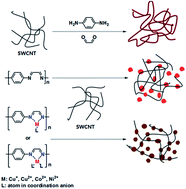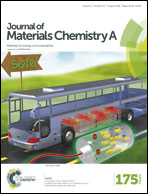A new strategy to construct thermoelectric composites of SWCNTs and poly-Schiff bases with 1,4-diazabuta-1,3-diene structures acting as bidentate-chelating units
Abstract
Although organic polymer/inorganic particle composites with thermoelectric (TE) performance have witnessed rapid progress in recent years, previous studies mainly focused on a few classically conducting polymers. Schiff base polymers have various advantages such as their ease of preparation, versatile derivatives and adjustable complexation. Unfortunately, studies of Schiff base TE composites are very scarce. The only example reported so far is obtained via a two-step procedure, i.e. synthesis of monomer and subsequent polymerization. Here, we report a convenient one-pot preparation and the TE performances of a series of flexible composite films based on single-walled carbon nanotubes (SWCNTs) and a novel poly-Schiff base, which is achieved via a condensation reaction between glyoxal and p-phenylenediamine. Furthermore, the TE performance of the poly-Schiff base composites reported herein can be conveniently adjusted by chelating transition metal ions. The results reveal that both the preparation method and the poly-Schiff base/SWCNT mass ratio have important impacts on the composite TE performance. The electrical conductivities and the Seebeck coefficients for the physically mixed composites exhibit opposite variation tendencies with poly-Schiff base/SWCNT mass ratio, while the power factors increase with increasing mass ratio. At a poly-Schiff base/SWCNT mass ratio of 1 : 3, the physically mixed composite reaches the highest power factor of 77.7 ± 5.8 μW m−1 K−2. Finally, by chelating transition metal ions with 1,4-diazabuta-1,3-diene unit of poly-Schiff base, the TE performances of poly-Schiff base/transition metal/SWCNT composites are conveniently adjusted.

- This article is part of the themed collection: 2016 Journal of Materials Chemistry A HOT Papers

 Please wait while we load your content...
Please wait while we load your content...